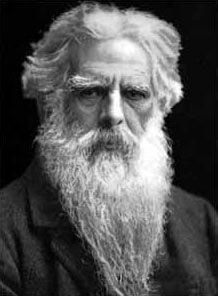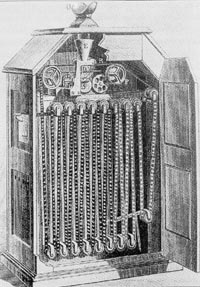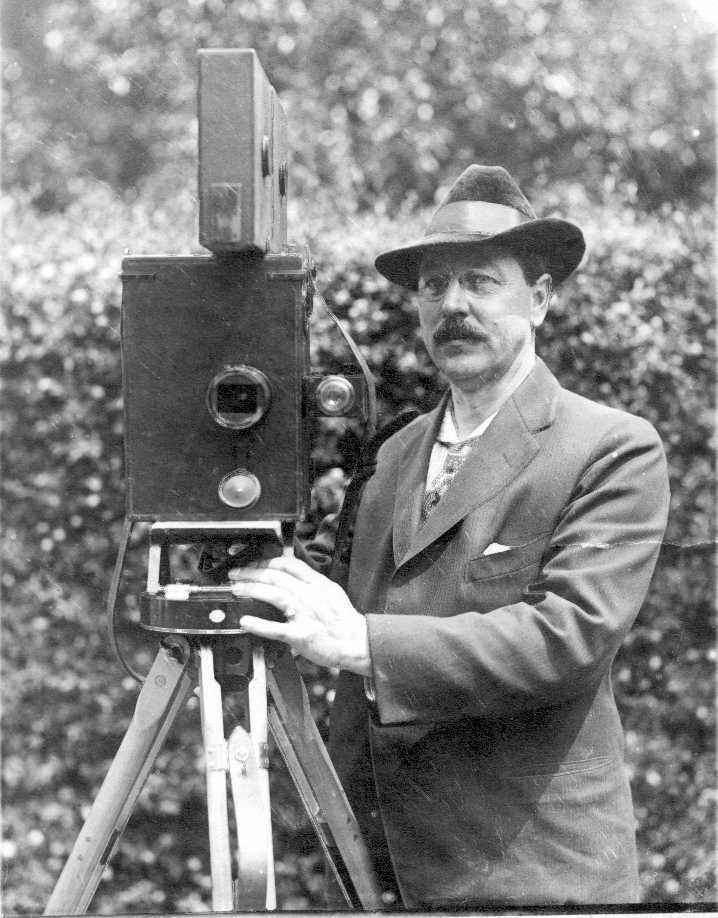Let's
Go to the Movies: The Mechanics of Moving Images
Movie
Pioneers
Muybridge
Leland Stanford unwittingly started a chain of events that contributed
to the development of motion pictures. To settle a wager regarding the position
of a trotting horse's legs, he sent for Eadweard Muybridge, a British photographer
who had recently been accclaimed for his photographs of Yosemite.
 Although Muybridge initially considered the task impossible, he made history
when he arranged 12 cameras alongside a race track. Each was fitted with a shutter
working at a speed he claimed to be "less than the two-thousandth part
of a second." Strings attached to electric switches were stretched across
the track; the horse, rushing past, breasted the strings and broke them, one
after the other; the shutters were released by an electromagnetic control, and
a series of negatives made. Though the photographs were hardly more than silhouettes,
they clearly showed that the feet of the horse were all off the ground at one
phase of the gallop. Moreover, to the surprise of the world, the feet were bunched
together under the belly. None of the horses photographed showed the "hobbyhorse
attitude" - front legs stretched forward and hind legs backward -so traditional
in painting.
Although Muybridge initially considered the task impossible, he made history
when he arranged 12 cameras alongside a race track. Each was fitted with a shutter
working at a speed he claimed to be "less than the two-thousandth part
of a second." Strings attached to electric switches were stretched across
the track; the horse, rushing past, breasted the strings and broke them, one
after the other; the shutters were released by an electromagnetic control, and
a series of negatives made. Though the photographs were hardly more than silhouettes,
they clearly showed that the feet of the horse were all off the ground at one
phase of the gallop. Moreover, to the surprise of the world, the feet were bunched
together under the belly. None of the horses photographed showed the "hobbyhorse
attitude" - front legs stretched forward and hind legs backward -so traditional
in painting.
 The photos were widely published in America and Europe. The
Scientific American printed eighteen drawings from Muybridge's photographs
on the first page of its October 19, 1878 issue. Readers were invited to paste
the pictures on strips and to view them in the popular toy known as the zoetrope,
a precursor of motion pictures. It was an open drum with slits in its side,
mounted horizontally on a spindle so it could be twirled. Drawings showing successive
phases of action placed inside the drum and viewed through the slits were seen
one after the other, so quickly that the images merged in the mind to produce
the illusion of motion.
The photos were widely published in America and Europe. The
Scientific American printed eighteen drawings from Muybridge's photographs
on the first page of its October 19, 1878 issue. Readers were invited to paste
the pictures on strips and to view them in the popular toy known as the zoetrope,
a precursor of motion pictures. It was an open drum with slits in its side,
mounted horizontally on a spindle so it could be twirled. Drawings showing successive
phases of action placed inside the drum and viewed through the slits were seen
one after the other, so quickly that the images merged in the mind to produce
the illusion of motion.
In 1880, using a similar technique with a device he named the
zoogyroscope, or zoopraxiscope, Muybridge projected his pictures on a screen
at the California School of Fine Arts, San Francisco." Motion pictures
were born...
Edison
and the movies
Thomas Edison was a prolific inventor,
numbering among his accomplishments multiple contributions to the art and technology
of motion pictures.
 Among Edison's contributions are the kinetograph
(camera) and the kinetoscope (viewing device), for which patents were filed
in 1892. The first batch of 25 kinetoscope units, marketed in 1894, sold for
$250 per machine. However, the kinetoscope and similar peephole, single user
devices were displaced by projection equipment within 10 years, except at amusement
arcades.
Among Edison's contributions are the kinetograph
(camera) and the kinetoscope (viewing device), for which patents were filed
in 1892. The first batch of 25 kinetoscope units, marketed in 1894, sold for
$250 per machine. However, the kinetoscope and similar peephole, single user
devices were displaced by projection equipment within 10 years, except at amusement
arcades.
Projectors, devised by the Lumiere brothers and American inventors
Thomas Armat and C. Francis Jenkins moved onto the scene in 1895. Edison, sensing
a new opportunity, negotiated a deal to manufacture the phantoscope, the invention
of Armat and Jenkins, for Raff and Gammon, a new entrant in the movie business.
Raff and Gammon renamed the machine "The Edison Vitascope",
forming the Vitaphone Corporation to distribute it and lease it on an exclusive
territorial basis in 1896. Vitaphone was arguably the first real motion picture
distribution company. However, Edison refrained from providing exhibition services.
Edison subsequently severed relations with the Vitascope Company. The Edison
Company manufactured its own projecting machine, the projectoscope (or projecting
kinetoscope), which reached the market in late February of 1897.
Edison aggressively protected his patents, and soon was embroiled
in a series of bitter lawsuits with othe manufacturers of motion picture equipment
and motion picture films.
 Although he lost key decisions concerning equipment
patents, he was successful in defending copyrights on the motion picture films
produced by his company.
Although he lost key decisions concerning equipment
patents, he was successful in defending copyrights on the motion picture films
produced by his company.
Edison produced a number of motion pictures, the first formally
released in 1894 for use with his kinetoscope. (A few demonstration films had
been prepared in the three preceeding years, but were not copyrighted.) Edison's 1894
picture was the first motion picture to be copyrighted, foretelling the years of copyright
wars to follow. As any user of Napster knows, copyright protection issues are
still with us.
Menlo Park (California) Inventor
Leon Forrest Douglass
- Worked as a messenger.
- Employed by a railroad.
- Awarded numerous patents for the phonograph and movie camera.
- Had his laboratory in Menlo Park.
- Established one of America's most familiar trademarks.
 It sounds like Edison, but it isn't.
Prolific inventor Leon Forrest Douglass made millions as the
cofounder of Victor Talking Records. The company name and the product name "Victrola"
came from his wife's name, "Victoria". Victor was one of Edison's foremost competitors.
It sounds like Edison, but it isn't.
Prolific inventor Leon Forrest Douglass made millions as the
cofounder of Victor Talking Records. The company name and the product name "Victrola"
came from his wife's name, "Victoria". Victor was one of Edison's foremost competitors.
Douglass invented the metal master disc to mass produce single
sided records. He then signed famed opera singer Enrico Caruso to sing for Victor
records. From audio recording, Douglass progressed to the motion picture industry, filing his
first color motion picture patent in 1916. A host of related inventions followed, and Douglass is believed
to have produced the first American full length color movie (Cupid Angling, with Ruth Roland,
Mary Pickford and Douglas Fairbanks) in 1918. Shorter films in color were released a year earlier.
When the Douglass family moved to the San Francisco Bay Area, he began a motion
picture company in San Rafael. After moving to Menlo Park in 1921 and equipping his mansion with
a machine shop, a laboratory and a theatre, he created
and patented another series of inventions including:
"Natural Color", a precursor of Technicolor
Camera for underwater photos
Panoramic cinematography
Multiple image photography
Cigarette lighter
Lee de Forest
 While in Palo Alto with the Federal Telegraph Company, Lee de
Forest improved his "Audion electronic vacuum tube to produce the first
genuine amplifier. This was an essential to both radio and telephonic long distance
communication.
While in Palo Alto with the Federal Telegraph Company, Lee de
Forest improved his "Audion electronic vacuum tube to produce the first
genuine amplifier. This was an essential to both radio and telephonic long distance
communication.
In 1913, de Forest moved to Southern California and produced
a series of inventions for recording both sound and pictures on the same film.
Patents on these were filed January 29, 1924.
De Forest was honored in 1959 with a Special Award from
the Academy of Motion Picture Arts and Sciences "for his pioneering inventions
which brought sound to motion pictures".
 |
This
page last updated:
September 17, 2001
Original content: Copyright © 2000, 2001 Museum of American Heritage
|
 Although Muybridge initially considered the task impossible, he made history
when he arranged 12 cameras alongside a race track. Each was fitted with a shutter
working at a speed he claimed to be "less than the two-thousandth part
of a second." Strings attached to electric switches were stretched across
the track; the horse, rushing past, breasted the strings and broke them, one
after the other; the shutters were released by an electromagnetic control, and
a series of negatives made. Though the photographs were hardly more than silhouettes,
they clearly showed that the feet of the horse were all off the ground at one
phase of the gallop. Moreover, to the surprise of the world, the feet were bunched
together under the belly. None of the horses photographed showed the "hobbyhorse
attitude" - front legs stretched forward and hind legs backward -so traditional
in painting.
Although Muybridge initially considered the task impossible, he made history
when he arranged 12 cameras alongside a race track. Each was fitted with a shutter
working at a speed he claimed to be "less than the two-thousandth part
of a second." Strings attached to electric switches were stretched across
the track; the horse, rushing past, breasted the strings and broke them, one
after the other; the shutters were released by an electromagnetic control, and
a series of negatives made. Though the photographs were hardly more than silhouettes,
they clearly showed that the feet of the horse were all off the ground at one
phase of the gallop. Moreover, to the surprise of the world, the feet were bunched
together under the belly. None of the horses photographed showed the "hobbyhorse
attitude" - front legs stretched forward and hind legs backward -so traditional
in painting.  The photos were widely published in America and Europe. The
Scientific American printed eighteen drawings from Muybridge's photographs
on the first page of its October 19, 1878 issue. Readers were invited to paste
the pictures on strips and to view them in the popular toy known as the zoetrope,
a precursor of motion pictures. It was an open drum with slits in its side,
mounted horizontally on a spindle so it could be twirled. Drawings showing successive
phases of action placed inside the drum and viewed through the slits were seen
one after the other, so quickly that the images merged in the mind to produce
the illusion of motion.
The photos were widely published in America and Europe. The
Scientific American printed eighteen drawings from Muybridge's photographs
on the first page of its October 19, 1878 issue. Readers were invited to paste
the pictures on strips and to view them in the popular toy known as the zoetrope,
a precursor of motion pictures. It was an open drum with slits in its side,
mounted horizontally on a spindle so it could be twirled. Drawings showing successive
phases of action placed inside the drum and viewed through the slits were seen
one after the other, so quickly that the images merged in the mind to produce
the illusion of motion.  Among Edison's contributions are the kinetograph
(camera) and the kinetoscope (viewing device), for which patents were filed
in 1892. The first batch of 25 kinetoscope units, marketed in 1894, sold for
$250 per machine. However, the kinetoscope and similar peephole, single user
devices were displaced by projection equipment within 10 years, except at amusement
arcades.
Among Edison's contributions are the kinetograph
(camera) and the kinetoscope (viewing device), for which patents were filed
in 1892. The first batch of 25 kinetoscope units, marketed in 1894, sold for
$250 per machine. However, the kinetoscope and similar peephole, single user
devices were displaced by projection equipment within 10 years, except at amusement
arcades. Although he lost key decisions concerning equipment
patents, he was successful in defending copyrights on the motion picture films
produced by his company.
Although he lost key decisions concerning equipment
patents, he was successful in defending copyrights on the motion picture films
produced by his company. It sounds like Edison, but it isn't.
Prolific inventor Leon Forrest Douglass made millions as the
cofounder of Victor Talking Records. The company name and the product name "Victrola"
came from his wife's name, "Victoria". Victor was one of Edison's foremost competitors.
It sounds like Edison, but it isn't.
Prolific inventor Leon Forrest Douglass made millions as the
cofounder of Victor Talking Records. The company name and the product name "Victrola"
came from his wife's name, "Victoria". Victor was one of Edison's foremost competitors. While in Palo Alto with the Federal Telegraph Company, Lee de
Forest improved his "Audion electronic vacuum tube to produce the first
genuine amplifier. This was an essential to both radio and telephonic long distance
communication.
While in Palo Alto with the Federal Telegraph Company, Lee de
Forest improved his "Audion electronic vacuum tube to produce the first
genuine amplifier. This was an essential to both radio and telephonic long distance
communication.